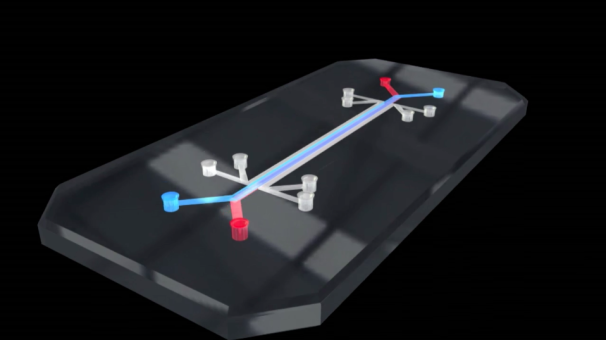药物体外测试新进展:实时3D细胞培养和芯片器官
| 导读 |
仍面临挑战的体外培养新技术有望替代现有的、用于药物测试的模型动物,具有纪念意义的是,日前政府拥有的360只黑猩猩正式从药物测试中退役,研究人员相信体外新技术将来可应用于药物测试和生理生化研究。
更灵敏的体外技术新平台被开发出并应用于研究人体药物代谢,从而让动物从药物试验中解放出来。动物保护组织也大力支持这一体外培养细胞和组织的方法,一些研发公... |

仍面临挑战的体外培养新技术有望替代现有的、用于药物测试的模型动物,具有纪念意义的是,日前政府拥有的360只黑猩猩正式从药物测试中退役,研究人员相信体外新技术将来可应用于药物测试和生理生化研究。
更灵敏的体外技术新平台被开发出并应用于研究人体药物代谢,从而让动物从药物试验中解放出来。动物保护组织也大力支持这一体外培养细胞和组织的方法,一些研发公司在体外测试领域推出创新性产品,包括支持细胞生长的独特支架以及平台系统。
据CSO Reinnervate创始人Stefan Przyborski称:“引进一些创新性平台可做到研究的集成性,并能提供传统细胞培养模型(涉及到在细胞2维底板上生长)不能生成的体外实时3D图像。对其需求不断提高的原因是,3D细胞培养新模型可生成细胞的自然3D表现型,从而支持了对其增殖、分化和功能的改进。”
Reinnervate公司目前向市场推出的Altavex™新品是一种聚苯乙烯支架,其作为平台技术支持细胞3D的常规培养。此外,该公司研发了3D皮肤支架(支持对化妆品和外用药物的测试),3D培养的肝细胞(支持对肝脏毒性的测试),3D平台(提高了不同干细胞的分化潜能)以及细胞侵袭模型(通过测试细胞的3D迁移能力评估抗癌化合物的疗效)。该公司还表示,目前正专注于商业设施的准备以支持对Altavex大规模生成的质量控制流程,今年晚些时候将推出其不同类型的正式产品。
体外3D细胞培养的障碍依存
HTStec的总经理John Comley博士在2010年的一份报告中谈到:“人们可能会得出这样一条结论,3D细胞培养的应用范围很广,也很容易生成组织,但是在HTStec调查中发现许多问题,如:仿生支架之间的细胞增殖能力差和3D矩阵组件太多。”
他还进一步提到,用户反映该技术在后期培养和细胞提取过程中很难操作,需要高通量的自动方法去解决。尤其注意的是,生理底板的种类以及其在长期试验中的稳定性都需要提高。
台湾国立成功大学的研究人员报告称,他们开发出高通量灌流技术、3D细胞微流体技术和综合系统以提供用户友好型的细胞培养工具,从而支持生物学家开展实验并获取精确数据。
值得注意的是,细胞培养的微流体系统是细胞试验中用途很广的工具,它是尚处于开发中的、不同于传统细胞培养法的革命性方法。一位研究人员称:“该技术应用的主要障碍是,用户操作时会遇到兼容检测方案的缺失,无法读出基于维流体技术的细胞检测结果。此外,该技术还缺少能填补维流体技术和传统细胞培养模型之间空缺的基本数据。
为了测试细胞培养模型中细胞增殖的效果以及获得药物敏感性结果,研究人员将新方法获取的数据和之前三种传统细胞培养的进行对比,发现了细胞培养的类型或导致不同的评价结果,值得警惕的是,当构建体外细胞培养模型(为了进行基于细胞的测试)时,有必要去研究不同培养体系中细胞的基本生理差异,以避免数据的任何误解。
但总体而言,集成性的微流体细胞培养系统克服了多个技术难题,并获得基本数据以协调不同方法获得的差异数据。
芯片上的器官
Hurel公司一直专注于在体外利用3D培养技术制造“芯片上的器官”,以模拟和预测肝脏和其它器官在体外的功能。上个月,CSO Reinnervate公司宣布其正接受美国人文学会(慈善协会)的融资以支持Hurel研制的细胞培养技术的新应用。

芯片上的器官(organ on a chip)
Hurel的微流体“生物芯片”包括分开的却流动性相连的“器官”或“组织”隔室,其中每一部分都支持活体细胞的培养,而微流体管道在微型泵的作用下允许培养液循环以模拟活体系统。公司称,该设备的几何形状和流动特性模拟了体内相关的生理参数,添加试验化合物后可在设备中循环。
一位HUREL官员称,该技术可适用于大量的实验应用,并兼容于任何类型的体外测定模式,如质谱、免疫组化、免疫荧光和基因表达检测。
芯片上的器官在医药研究中的巨大潜力
芯片上的器官可以模拟真正的人体试验,透明的芯片让药物测试变得易于研究者进行观测。当需要测试一种新的药物时,只需要将药物所含的化合物加入到芯片中,即可观察芯片中的细胞(心脏细胞、肝脏新报等)的反应情况。
药物研发是一个漫长,且耗资巨大的过程。在药物研发中,动物试验是必不可少的一个环节。但是由于人体的复杂性,动物试验并不能完全反映人类疾病对药物的反应情况。动物试验与人体真实情况之间的差异可能导致这样一种情况:某种药物通过了动物实验,却无法通过人体实验,因而无法真正投产上市,还造成了严重的成本浪费。利用芯片上的器官进行药物试验,则可以尽可能地模拟人体真实情况,从而降低药物研发的成本与风险。
许多人类疾病是没有动物模型可供测试的,比如“克罗恩病”——也称为“节段性肠炎”,多发于青年女性身上,但至今发病原因不明,也缺乏有效的治疗手段,最大的原因就是无法找到同样患有这种疾病的动物来进行药物测试,而利用“芯片上的肠道”,这个问题迎刃而解。
在疾病研究与药物试验中,传统的方法不可避免地要利用到动物,这招到了动物保护组织的非议。利用芯片上的器官技术则可以避免许多动物保护方面的道德问题。
开发芯片上的器官的代表性机构
1.Wyss研究所
哈佛大学Wyss生物启发工程研究所利用自然设计原则开发仿生材料与设备。Wyss研究所的官网对自己的描述是“创新、合作与技术转化的新模式”,该研究所的主要研究方向有适应性材料技术、仿生机器人、合成生物学、仿生微系统、可编程的纳米材料等。其中仿生微系统即“芯片上的器官”技术。
一位HUREL官员称,该技术可适用于大量的实验应用,并兼容于任何类型的体外测定模式,如质谱、免疫组化、免疫荧光和基因表达检测。
芯片上的器官在医药研究中的巨大潜力
芯片上的器官可以模拟真正的人体试验,透明的芯片让药物测试变得易于研究者进行观测。当需要测试一种新的药物时,只需要将药物所含的化合物加入到芯片中,即可观察芯片中的细胞(心脏细胞、肝脏新报等)的反应情况。
药物研发是一个漫长,且耗资巨大的过程。在药物研发中,动物试验是必不可少的一个环节。但是由于人体的复杂性,动物试验并不能完全反映人类疾病对药物的反应情况。动物试验与人体真实情况之间的差异可能导致这样一种情况:某种药物通过了动物实验,却无法通过人体实验,因而无法真正投产上市,还造成了严重的成本浪费。利用芯片上的器官进行药物试验,则可以尽可能地模拟人体真实情况,从而降低药物研发的成本与风险。
许多人类疾病是没有动物模型可供测试的,比如“克罗恩病”——也称为“节段性肠炎”,多发于青年女性身上,但至今发病原因不明,也缺乏有效的治疗手段,最大的原因就是无法找到同样患有这种疾病的动物来进行药物测试,而利用“芯片上的肠道”,这个问题迎刃而解。
在疾病研究与药物试验中,传统的方法不可避免地要利用到动物,这招到了动物保护组织的非议。利用芯片上的器官技术则可以避免许多动物保护方面的道德问题。
开发芯片上的器官的代表性机构
1.Wyss研究所
哈佛大学Wyss生物启发工程研究所利用自然设计原则开发仿生材料与设备。Wyss研究所的官网对自己的描述是“创新、合作与技术转化的新模式”,该研究所的主要研究方向有适应性材料技术、仿生机器人、合成生物学、仿生微系统、可编程的纳米材料等。其中仿生微系统即“芯片上的器官”技术。
今年2月, Don Ingber博士因为获得了英国国家动物实验取代、精致、减量研究中心(National Centre for the Replacement, Refinement and Reduction of Animals in Research)颁发的著名的3R奖。3月份,毒理学协会还授予Don Ingber博士“基础科学前沿奖”,理由是他“在理解毒理机制上的开创性贡献与推动作用”。
2. Zyoxel公司
Zyoxel是英国牛津大学Isis科技创新的衍生公司。基于美国麻省理工学院Linda Griffith教授和Steven Tannenbaum教授实验室的研究成果,Zyoxel公司在LiverChip平台上开发具有免疫活性的人类肝脏模型,用于帮助研究免疫接到的药物损伤性肝损伤的病因。Zyoxel公司所研发的技术意在提高临床预科药物检测效果并减少动物实验次数。
此外,在美国国防部先进研究计划署(DARPA) 2630万美元的资助下,Zyoxel公司与MIT的研究员以及其他公司正合作开发芯片上的微型人体线路——也就是芯片上的人体。该项目旨在在一个单一的集成芯片上整合10组微型人体仿生器官,从而提供一个预测新药物和疫苗安全性的多功能平台。
3. 日本东京大学应用生物化学系
2010年11月,日本东京大学应用生物化学系的科学家宣布他们构建了一种芯片,可以同时试验肝脏、肠道以及乳腺癌细胞对抗癌药物的反应。该研究团队表示,这种微型生物检测系统可替代传统的检测方法,具有成本低廉的优势,且可以减少新药研发测试中所需的动物数量。
日本可科学家开发的芯片由一玻璃片,两片聚二甲基硅氧烷(PDMS)构成。在芯片上有利用光刻法蚀刻出的两条微型通道和三个微腔室。肠道细胞、肝脏细胞以及乳腺细胞分别培养于三个微型腔室中,两条微型通道则起着肠道和血管的作用。利用这套系统,科学家进行了抗乳腺癌药物以类雌激素药物(可刺激乳腺癌细胞生长)的试验。
原文链接:
Engineering challenges for instrumenting and controlling integrated organ-on-chip systems.
The sophistication and success of recently reported microfabricated organs-on-chips and human organ constructs have made it possible to design scaled and interconnected organ systems that may significantly augment the current drug development pipeline and lead to advances in systems biology. Physiologically realistic live microHuman (μHu) and milliHuman (mHu) systems operating for weeks to months present exciting and important engineering challenges such as determining the appropriate size for each organ to ensure appropriate relative organ functional activity, achieving appropriate cell density, providing the requisite universal perfusion media, sensing the breadth of physiological responses, and maintaining stable control of the entire system, while maintaining fluid scaling that consists of ~5 mL for the mHu and ~5 μL for the μHu. We believe that successful mHu and μHu systems for drug development and systems biology will require low-volume microdevices that support chemical signaling, microfabricated pumps, valves and microformulators, automated optical microscopy, electrochemical sensors for rapid metabolic assessment, ion mobility-mass spectrometry for real-time molecular analysis, advanced bioinformatics, and machine learning algorithms for automated model inference and integrated electronic control. Toward this goal, we are building functional prototype components and are working toward top-down system integration.
Workshop meeting report Organs-on-Chips: human disease models.
The concept of "Organs-on-Chips" has recently evolved and has been described as 3D (mini-) organs or tissues consisting of multiple and different cell types interacting with each other under closely controlled conditions, grown in a microfluidic chip, and mimicking the complex structures and cellular interactions in and between different cell types and organs in vivo, enabling the real time monitoring of cellular processes. In combination with the emerging iPSC (induced pluripotent stem cell) field this development offers unprecedented opportunities to develop human in vitro models for healthy and diseased organ tissues, enabling the investigation of fundamental mechanisms in disease development, drug toxicity screening, drug target discovery and drug development, and the replacement of animal testing. Capturing the genetic background of the iPSC donor in the organ or disease model carries the promise to move towards "in vitro clinical trials", reducing costs for drug development and furthering the concept of personalized medicine and companion diagnostics. During the Lorentz workshop (Leiden, September 2012) an international multidisciplinary group of experts discussed the current state of the art, available and emerging technologies, applications and how to proceed in the field. Organ-on-a-chip platform technologies are expected to revolutionize cell biology in general and drug development in particular.
Scaling and systems biology for integrating multiple organs-on-a-chip.
Coupled systems of in vitro microfabricated organs-on-a-chip containing small populations of human cells are being developed to address the formidable pharmacological and physiological gaps between monolayer cell cultures, animal models, and humans that severely limit the speed and efficiency of drug development. These gaps present challenges not only in tissue and microfluidic engineering, but also in systems biology: how does one model, test, and learn about the communication and control of biological systems with individual organs-on-chips that are one-thousandth or one-millionth of the size of adult organs, or even smaller, i.e., organs for a milliHuman (mHu) or microHuman (μHu)? Allometric scaling that describes inter-species variation of organ size and properties provides some guidance, but given the desire to utilize these systems to extend and validate human pharmacokinetic and pharmacodynamic (PK/PD) models in support of drug discovery and development, it is more appropriate to scale each organ functionally to ensure that it makes the suitable physiological contribution to the coupled system. The desire to recapitulate the complex organ-organ interactions that result from factors in the blood and lymph places a severe constraint on the total circulating fluid (∼5 mL for a mHu and ∼5 μL for a μHu) and hence on the pumps, valves, and analytical instruments required to maintain and study these systems. Scaling arguments also provide guidance on the design of a universal cell-culture medium, typically without red blood cells. This review presents several examples of scaling arguments and discusses steps that should ensure the success of this endeavour.

来源:生物探索
 腾讯登录
腾讯登录
还没有人评论,赶快抢个沙发